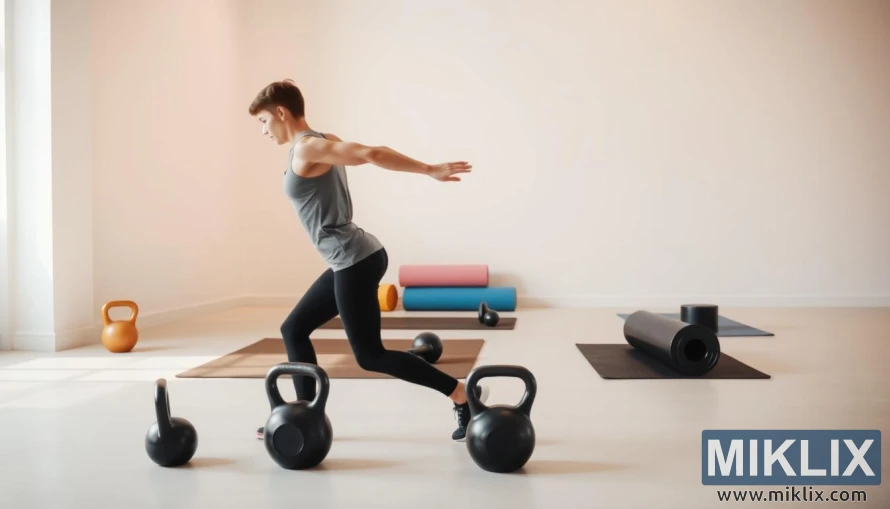Image: Kettlebell Mobility Training
Published: April 3, 2025 at 4:35:33 PM UTC
Last updated: September 24, 2025 at 3:45:18 PM UTC
Well-lit studio with a person performing kettlebell mobility drills, surrounded by props, emphasizing flexibility, strength, and functional movement.
In the bright expanse of a minimalist studio, where natural light streams in and warms the clean surfaces of the floor and walls, a figure moves with precision and intent. Their body arcs into a dynamic position, one leg extending backward in balance while the arms stretch outward to maintain poise. The movement is fluid yet deliberate, a seamless blend of strength and control, demonstrating not only physical capability but also an intimate awareness of form. This is mobility training at its essence—more than simple exercise, it is a dialogue between the body and its potential. The kettlebells scattered purposefully across the space are not just weights; they are catalysts, tools designed to challenge balance, stability, and coordination as much as raw power.
The individual’s posture speaks volumes about discipline and focus. The extended leg behind them suggests strength in the posterior chain, while the bent supporting leg anchors their stance with stability. Their torso remains upright, core engaged, and gaze steady, the embodiment of controlled motion. Unlike static lifting, this moment emphasizes dynamic balance, training the muscles and joints to adapt and respond, improving resilience against strain or injury. The hands stretch outward not for flair but for equilibrium, the natural counterweight to the shifting forces of gravity and the kettlebells aligned in front. In this instance, the human body becomes both the instrument and the art, moving with grace but rooted in function.
Around the central figure, the studio environment enhances the sense of purposeful movement. Yoga mats lie neatly arranged across the polished floor, their muted colors introducing subtle warmth to the minimalist space. Foam rollers rest nearby, waiting to release tension from fatigued muscles, reminders that recovery is as vital as exertion. A small collection of kettlebells of varying sizes punctuates the room, their matte black surfaces suggesting durability and readiness. Each object in the space is functional, nothing extraneous, contributing to an atmosphere of clarity and discipline. The scene is one of balance—between simplicity and intensity, between the softness of light and the hard challenge of weight.
The lighting in particular plays a transformative role. Gentle yet abundant, it casts a glow that highlights the smooth lines of the figure’s form and the textures of the equipment without overwhelming either. Shadows are soft, suggesting harmony rather than conflict, reinforcing the impression that this session is as much about mindful movement as it is about strength. The clean white walls reflect this light evenly, removing distraction and amplifying focus. It feels less like a gym and more like a sanctuary, a space where one can reconnect with their body through deliberate, functional training.
In essence, the moment captured is not simply about exercise but about cultivating longevity and freedom of movement. Kettlebell mobility training, as depicted here, goes beyond aesthetics, targeting the joints, tendons, and stabilizing muscles often overlooked in traditional strength programs. It teaches adaptability, fluidity, and resilience—qualities as necessary in daily life as they are in athletic performance. Watching the poised balance of the figure, framed by the ordered tools of practice and the calm of the studio, one sees a philosophy of training that values movement as medicine, strength as fluid, and discipline as liberating. This is the embodiment of purposeful training: a quiet yet powerful reminder that mobility is not just an accessory to strength but its foundation.
The image is related to: Kettlebell Training Benefits: Burn Fat, Build Strength, and Boost Heart Health

